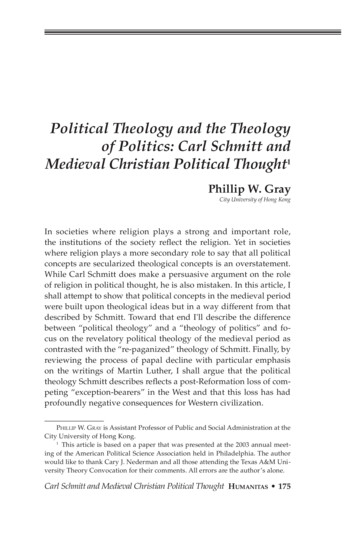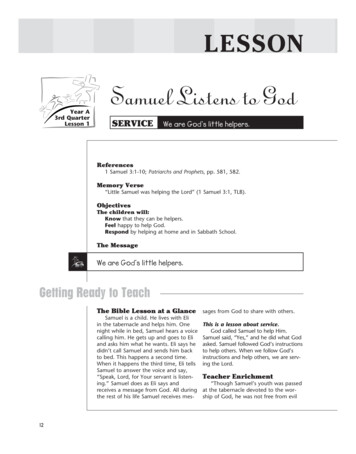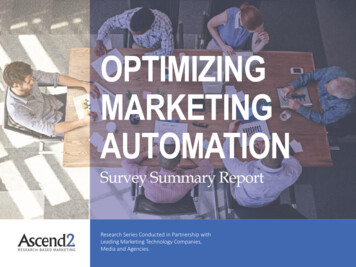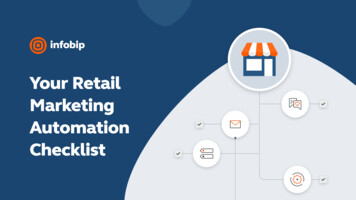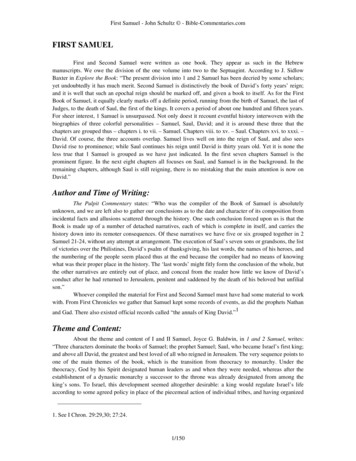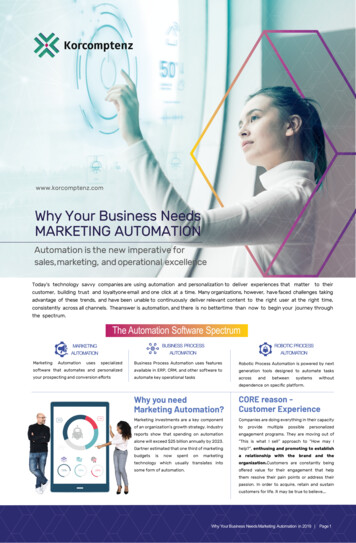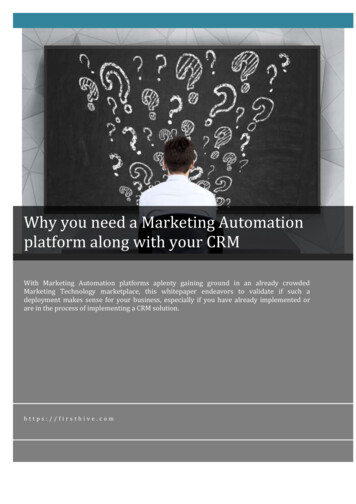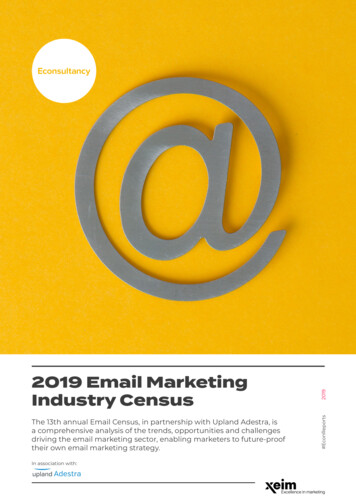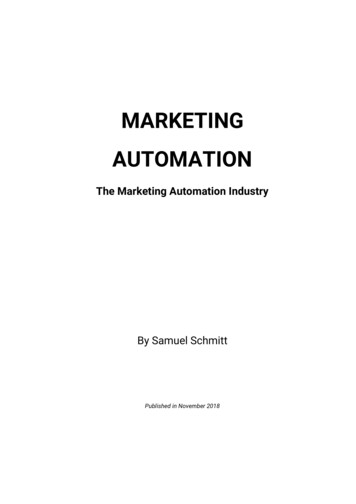
Transcription
MARKETINGAUTOMATIONThe Marketing Automation IndustryBy Samuel SchmittPublished in November 2018
TABLE OF CONTENTSPreface3Introduction5What is marketing automation software6HistoryChallenges faced by marketing professionals in the digital ageCharacteristics of marketing automation softwareDifference between email marketing and marketing automationTrend: What are the innovationsMarket overview: a rapidly emerging marketFacts and FiguresMacro-environmental mentalLegalCompetitors AnalysisSegment 1: The GiantsSpotlight on SalesforceSegment 1: The LeadersSpotlight on HubspotSegment 3: Vendors for small businessesSpotlight on MailchimpDistribution and Role of the business partnersDirect SellingBusiness PartnerCustomersOpportunities and 161819212223252627272728303030Conclusion31About the author32Samuel Schmitt samuelschmitt.com 1
PrefaceIn 2017, I decided to challenge myself with a full year of studies, remote and onsitelessons about sales and marketing. My main motivation was to learn and alsoextend the scope of my competencies. Indeed, I have an IT background andbelieve that in this digital world having an expertise spanning a significant numberof different subject areas is key.This year 2017 was really hard. During the day, I worked for my regular job at asoftware company, and by night I had to study to get this master in Sales andMarketing. Besides preparing the exams, I had to write and present a dissertationabout a topic of my choice.Marketing Automation was my topic. Why?I spent 7 years working as a solution architect and then as a sales manager for asoftware company selling Content Management System. I could have taken theeasiest way and speak about the CMS industry.But I wanted to discover another industry and understand better the marketingautomation software and especially their customers, the marketing people.Marketing automation is fundamental in the digitalisation of marketing activities. Itenables various marketing strategy such as the inbound marketing approach.Properly executed it improves the performance of the marketing team, and overallof the company.For this study, I read a lot of analyst reports or marketing blogs. Gatherinformation from various sources. Analyzed all these pieces to finally produce thisdocument. In November 2018, I finally decided to publish it and share it with theworld. No cut or edit has been made to this dissertation. It is the same exact copy(with its academic style) that was presented in front of the jury of the university inDecember 2017. Few things happened in the marketing automation in one year.And I consider that most of the study is still accurate.Hopefully, you will enjoy reading this document. It might even help you with yourdaily marketing activities or for another academic research.-- SamuelSamuel Schmitt samuelschmitt.com 2
IntroductionDigital Marketing is living an (r)evolution. In the last decade, new practicesappeared and transformed the way marketers do their job. This transformation isin working order and is supported by the improvement of information andcommunication technologies. Web 2.0, Cloud computing, Social Networks and BigData delivered the foundation of a new paradigm for marketing in the digital era.Multiple systems were developed in order to answer the constantly changingrequirements of digital marketing. Content Management System’s emerged for thecreation and publication of content online, supporting a consistent customerexperience. Marketing Automation tools were created to automate daily marketingtasks such as connecting with people via email. Customer RelationshipManagement tools were built to store information about prospects and customersand were primarily used by marketing and sales to gain a better overview of thesales funnel. Analytics tools provide accurate statistics about the interaction ofthe visitors with multiple touch points. We could also enumerate E-commerceSystems, Enterprise Content Managers and many other systems supportingmarketing strategies in this digital era.In the following dissertation, the focus will be on a particular segment of themarketing software industry: Marketing Automation Software.We will see that this industry is generating a lot of revenue. Billions are spent everyyear by companies to acquire new marketing platforms. Platforms that help themto reach potential customers, generate sales leads, and at the end generate morerevenue for those companies. These platforms can help companies to get moreprofit and stay ahead of the competition.The industry has a high potential for growth so it is more competitive. Establishedsoftware vendors are ruling the market since 2000. The leaders of the market seenewcomers every year, trying to get a piece of cake. The strategy to get marketshare and to be recognized in this crowded market is to be innovative. The trend issurfing on the artificial intelligence wave. New companies claim to help marketerswith intelligent systems.Samuel Schmitt samuelschmitt.com 3
1.What is marketing automation software1.1.HistoryMarketing Automation started in 1992 with the release of Unica. At this time, mostbusinesses were still offline and the internet was still not really developed,therefore neither were online marketing practices. The US company was originallybuilt to serve organisations with basic marketing tools. In 2010 it was bought byIBM and is currently part of IBM's extensive marketing solutions.The rise of the World Wide Web in the 2000’s had a huge impact on howcompanies could do business. Their customers were online and accessibleworldwide. The web moved from static pages (Web 1.0) to a more dynamic mediaenabling interaction between users and pages.In order to answer the new challenges faced by businesses and to capture thoseinteractions, a new generation of tools appeared to support this rapidly growingonline audience. Between 2000 and 2005 companies such as Eloqua, Silverpop,Pardot, Neolane, Infusionsoft entered the online marketing sphere.At the same time, consumers began to access digital information not only fromtheir desktop but also on their mobile and through social networks. These newchannels have opened new perspectives for marketers.In parallel, cloud computing became more accessible thanks to companies suchas Amazon and its Amazon Web Service (AWS) that enabled software companiesto deploy their application on a global scale. Tools such as Ontraport (2006),Hubspot (2006), Act-On (2008) and Marketo (2006) started to offer Software as aService (SaaS) to marketing professionals.Samuel Schmitt samuelschmitt.com 4
The success of these marketing software companies was remarkable and theearly companies from the 2000’s were almost all acquired in the 2010’s by the bigplayers such as Salesforce (Pardot), Oracle (Eloqua), IBM (Silverpop and Unica),and Adobe (Neolane).These big players built up a marketing suite made of several softwares (Analytics,Marketing Automation, CRM, CMS) in order to provide all-in-one solutions alsoknown as Marketing Cloud.Another side of history shows us that with each technological revolution, newtools appeared on the market and developed the capabilities of online marketing.1.2.Challenges faced by marketing professionals in the digitalageData. Big data. This could be one of the main challenges marketing teams arefacing. They are overwhelmed with a lot of information to manage, analyse andcomprehend. Many input channels (website, mobile, social networks) drive visitorsto their online content. Marketers have to understand their visitors, their behaviourand how to use the data collected in an efficient way.It is great to have traffic through a website or any other online channels, but thechallenge that marketing professionals are faced today is to convert that trafficinto leads, resulting in new customers. An understanding of what content isperformant, what content converts, what type of users convert and on what type ofcontent is critical. As any successful digital marketing case study will claim,marketing professionals must make use of comprehensive analytics,segmentation, targeting and lead-scoring systems, in order to succeed andultimately gain new customers.Time and budget are limited resources. Being performant is a tough challenge.Automation of activities such as emailing and marketing campaign on multiplechannels is a strong requirement. Also to be performant the marketing team needssimple tools, with a smooth onboarding process. They don't have to do intensivetraining or hire an expert to do simple tasks.In most cases, time and budget are limited resources for marketing teams today,so being performant is of the utmost importance. It is also a tough challenge todesign, implement and monitor marketing campaigns on multiple channels,especially in big teams which is why it is appealing to use tools that are easy to setup and that can automate such processes.Samuel Schmitt samuelschmitt.com 5
Closing the gap between marketing and sales. Historically marketing and salesteams always have a gap in communication but digitalisation has made this gapbigger, especially in medium to large organisations. In an ideal journey, Marketingdepartments collect information about potential customers, nurture them withcontent, make them Marketing Qualified Leads, then hand those leads over to thesales departments whose job it is to move the leads through the funnel and collectfurther information about the potential client. The data collected should then besynchronized between the two departments so that marketing can evaluate whathas worked and what needs to be improved in the marketing strategy. More oftenthan not, this step is missing and the loop is not closed.To summarise, these are the requirements of marketing professionals in today'sdigital age: Lead Generation.Data management.Automation (Email and Campaign).Analytics / Scoring.Marketing and Sales funnel synchronization.Easy to use.Saving Time.1.3.Characteristics of marketing automation softwareMarketing automation is the activity that defines the execution, management andautomatisation of marketing tasks. Marketing automation platforms are softwaressupporting these marketing activities. Marketing automation doesn’t exist withouttechnology.Marketing automation software is promising increased revenue and improvedreturn on investment by facilitating lead nurture campaigns that provide specificcontent aligned to the buyer’s needs and lead scoring models that deliver warmedleads to the sales team.Samuel Schmitt samuelschmitt.com 6
Here the common functionalities of a marketing automation system: Tracking: Capturing user information across multiple online channels(website, email, social channel). Every single interaction with any touchpointis tracked into the system. Contact Management: Management of all the user information collected ina central database. Lead Scoring: Scoring of the potential of a person to become a futurecustomer. Each time a visitor does an action such as visiting a page,downloading a document or reading an email, he gets a certain score. Thisscore is an indication of his potential of becoming a future customer. Automation of marketing campaigns: Creation of workflows that will sendthe appropriate information (personalised information) on the appropriatechannel (email/web/social/SMS) based on the behaviour of the user. Email Design: Create WYSIWYG emails with a simple editor tool. Analytics and reporting: Giving an overview of the marketing funnel andperformance of marketing campaigns. Export data and generate reports.The features above are the core features. Any marketing automation system mustprovide at least these features in order to be considered from this category.Others functionalities are sometimes as well offered by Marketing Automationvendors: Content Management: Creation of landing pages or blog pages that can aswell be personalised. AB Testing: AB Testing of Email campaigns and content if provided. CRM Integration: Bi-directional synchronisation of the information betweenthe marketing system and a CRM. The marketing platform must push datato the CRM (e.g Contact information) and also pull content from the CRM. Built-in CRM: CRM to organize, track, and grow the sales pipeline within thesame interface. Social Media: Capability to monitor social networks activities, providesmechanisms to automate publication and reporting. Native Mobile Application: A mobile application to access all the datadirectly from a smartphone. Some action might as well be executed from asmartphone.Samuel Schmitt samuelschmitt.com 7
1.4.Difference between email marketing and marketingautomationIt is important to understand the difference between email marketing andmarketing automation. Even though the differences can be sometimes thin.To make it simple, Email marketing is only about sending mass email and tracksopen rates and clicks. When marketing automation goes beyond and adds on topof it the features described before. Marketing Automation allows you to automateemail workflow, track user behaviour on different channels and score them.When the goal of Email Marketing is to facilitate the email communicationbetween a company and a mass of users, Marketing Automation goal is to nurturethe user with relevant information and drive qualified leads to sales.Later in the document, email marketing vendors will be as well study as they startproviding automation features for small businesses.1.5.Trend: What are the innovations2017 was the year of Machine Learning and Artificial Intelligence being applied tomarketing practices. These machine learning systems should use all the datacollected about the customers over many years. It will tell the marketer how likelya simple visitor might turn into a customer and what should be done to improvethe lead conversion. This could also be referred to as predictive analytics.Past interactions are not only described in various reports or graph charts but arealso used to predict what could happen and suggest potential action to initiatesuch as the next campaign for a specific customer.The nature of machine learning for marketing is to give a deeper understanding ofthe potential customer and about its journey across online channels. Therefore,this “ intelligence ” can serve personalisation in order to give an even more accuratepersonalised experience.The perspective for the next 3-5 years shows that companies will invest a lot inmarketing analytics. The CMO Survey study indicates an investment of 375% inthis area1.CMO /(2017).1Samuel Schmitt samuelschmitt.com 8
A parallel with the rise of AI in marketing practice could be done here as AI willimprove analytics capabilities with features such as predictive analytics andmachine learning.2.Market overview: a rapidly emerging market2.1.Facts and FiguresWith an industry revenue of about 200 Million EUR in 2010, the market has grownby 20 the last 6-7 years and was estimated at around 4 Billion EUR in 2016. Someforecasts expect to see the Marketing Automation Software market to grow up to5.5 Billion EUR in 2019, at a CAGR of 8.55%. On the longer term, the marketrevenues might reach between 7.5 Billion EUR and 8.5 Billion EUR in 2025. If thepredictions are accurate, the industry could double its size within the next decade.Marketing Automation Software is one of the leading industry in the marketingsoftware business. Based on the information from the well known “ MarketingTechnology Landscape Supergraphic ”2 (see picture below), the number ofcompanies providing marketing automation product around 203 in 2017, thisrepresents about 4% of the marketing tools.The number of companies from this same category was around 260 in 20163. Thisrepresents a growth of 25%. If we include companies providing as well emailmarketing, the number of companies goes up to 350 in rketing-techniology-landscape-supergraphic-2017/ /marketing-technology-landscape-supergraphic-2016/ (2016).2Samuel Schmitt samuelschmitt.com 9
Marketing automation has grown at such a speed that as of 2016, a reported 49%of companies are using the technology in their marketing strategies. And for B2Bcompanies, this figure rises to 55%. To put this into perspective, almost 11 timesmore companies are using automation that was in 2011. And this growth is onlyset to continue as 50% of companies are still not familiar with marketingautomation.For example, The mid-sized businesses about two million companies (in the US)and about 6 Billion EUR to 8 Billion EUR in market opportunity only the US. Almostnone of them, with the exception of tech companies, have invested in marketingautomation to date.By breaking down the segments, even more, we can identify that marketingautomation is still in its early stages as evidenced by penetration at less than 10%among the SMB and micro-segments. For obvious reasons, larger companiesadopted marketing automation practice first, but the trend set is now followed bysmaller companies.Samuel Schmitt samuelschmitt.com 10
Source: Digital Capital Advisors, “Marketing Technology Sector Update: Marketing Automation”(2015)2.2.Macro-environmental factorsIn this section, we will use the PESTEL framework in order to understand whatfactors could have an influence on the marketing software industry.2.2.1.PoliticsGovernments do not intervene in the economy of marketing software, or theirinterventions are minors. The politic factor is irrelevant to the current analysis.2.2.2.EconomicsMarketing budgets are continuing to rise, according to a survey of marketingexecutives by Gartner, Inc4. Fifty-seven percent of marketing leaders surveyedexpect their budgets will increase more than 12% in 2017. The study illustrates aswell that the money goes mainly to their website. Websites are seen as their mostimportant lead generation channel and this is where half of the people interviewedwill spend their budget.Another study from the CMO Survey5 confirms this trend. Marketing budgets nowcomprise 11 percent of total company budgets on average and have ting-budgets-continue-to-climb/ (2016).5CMO Survey, h ttps://cmosurvey.org/ (2017).4Samuel Schmitt samuelschmitt.com 11
increased over the last years. Tech companies are ones of the biggest spendersby this measure, allocating 13.8 percent of revenue to marketing.Moreover, the study breakdowns the marketing expenses by industry and theresult shows that B2B product companies are the ones allocating most of theirmarketing budget on direct marketing expenses. 66% of B2B product companiesinclude expenses for digital marketing, advertising, trade promotions in theirmarketing budgets.This may be because B2B product companies invest more in their inbound channelto generate revenue. Their lead generation and sales processes are done moreand more via online channels.2.2.3.SocialHere let’s focus on one particular population, the Millennials, people born between1980 and the 2000’s.By 2025, Millennials will comprise three-quarters of the global workforce6. In theUSA, they are about 80 Million, more than the population of the baby boomers theirparents7.But the trend is different in Europe, Millennials represent a minority of thepopulation8. France is a special case in Europe as its growth rate is higher than inthe other European countries. The French millennials are about 16 Million todayand will represent half of the workforce in 5 years9.This generation will have (or already have) a predominant role in organisations.Within the next decade, they will become decision makers. More than any othergeneration, Millennials have technology at their fingertips. They were born with acomputer, they are using social networks, communicating through messagingplatforms, they have dozens of applications on their smartphone, shop online andjudge a brand by its online presence.As users of enterprise software, Millennials feel comfortable learning new systemsand using them. They are fairly open to emerging fields, technologies orapplications and are willing to try them if those new systems let them reach theirEY, Global Generations: A Global Study on Work-Life Challenges Across Generations (2015): p. 1.Pew Research 4/25/millennials-overtake-baby-boomers/ (2016).8Pew Research 2/09/who-are-europes-millennials/ (2015).9Insee, https://www.insee.fr/fr/statistiques/1913143 (2017).67Samuel Schmitt samuelschmitt.com 12
goal. However, when they want something, they want it now. They are more opento change to new systems when the previous one become obsolete or does notinnovate as expected.2.2.4.TechnologicalBig data represents dataset produced by people using the internet. These data areso large or complex that traditional data processing application software isinadequate to deal with them. Therefore the support of special tools and methodsare required. In a nutshell, all the information collected about people is becomingso important that simple human or even simple systems cannot process them,cannot understand them anymore.The multiplication of touchpoints such as mobile, social network, smart TV,connected devices (IoT) is an aggravating factor to the big data. The total amountof data in the world was 4.4 zettabytes in 2013. That is set to rise steeply to 44zettabytes by 202010.Big data has many contributions to marketing today, and especially in the area ofanalytics and to be more specific: Predictive analytics.In marketing, it can provide important information about which content attractsusers and convert them into leads. Which content is the most effective at eachstage of a sales cycle. Based on the analysis of thousands of users journey, itcould tell you what users will most likely become a customer. Or what next pieceof content should nurture the lead in order to make him a better-qualified lead.It is all about processing thousands and thousands of user information to getbetter leads, leading to higher sales rates.After spending years collecting data from various sources, those data contributeto the AI revolution that is emerging. Those data help for the training andacquisition of knowledge of machine learning systems.AWS and Google, came with a new generation of cloud instances that facilitate thesetup of machine learning based systems11.From the application development side, more and more frameworks enable thedevelopment of Artificial Intelligence. For example, Tensorflow - An open-sourcesoftware library for Machine Intelligence developed by Google12.Northeastern 016/05/13/how-much-data-produced-every-day/ (2016)11Google, h ttps://cloud.google.com/products/machine-learning/ (2017)12The form-play (2017)10Samuel Schmitt samuelschmitt.com 13
And to finish, in order to accumulate all these data and run softwares that are ableto process all these data. The power of the cloud is needed.Amazon Web Services, the leader of cloud computing, and other actors such asGoogle, Microsoft or IBM provide since many years services to enterprises in orderto let them deploy IT infrastructure at lower cost and at a larger scale.Hosting and storage are getting cheaper every year. AWS report the price of the GBhas been reduced by 80% since the release of its services back in 200613.Computing power is more and more affordable. AWS did more than 50 price cutsince 2006 in its EC2 offering14.Besides the price getting cheaper, here the offering has been extended in term ofsizing of the instances and as well regarding the availability of the service.Companies pay per use, and this could go down to the request or second. AWSand its competitors made the cloud mature and helped to the democratisation ofsoftwares as a service. Big data infrastructure let companies store their date in thehuge server farms provided by cloud computing providers.2.2.5.EnvironmentalDespite the servers farm having an impact on global warming, there are noenvironmental factors that interfere with the software business. People still seesoftware as a green industry.2.2.6.LegalFrom a legal perspective, the most restrictive regulation is the EU General DataProtection Regulation (GDPR). It replaces the previous Data Protection Directivesand was designed to harmonize data privacy laws across Europe and, to protectand empower all EU citizens data privacy and to reshape the way organizationsacross the region approach data privacy. The GDPR includes more than 50 articlesand must be implemented by each of the 28 EU member states by May 201815.Amazon, e-s3-glacier-price-reductions(2016)14Thesis Kurt 010)15EUGPDR, http://www.eugdpr.org/ (2017)13Samuel Schmitt samuelschmitt.com 14
Main principles of the GDPR: Consent: Consent must be “ explicit ” for sensitive data. Organisations isrequired to be able to demonstrate that consent was given. And It must beas easy to withdraw consent as it is to give it. Data governance strategy: Organisation will have to be accountable for thedata collected, notify people in case of a data breach, and on request givefull access to the data collected or erase personal data. Privacy by Design: It calls for the inclusion of data protection from the onsetof the designing of systems, rather than an addition. Organisations shallimplement appropriate technical and organisational measures in aneffective way in order to meet the requirements of this regulation andprotect the rights of data subjects.GDPR could be an opportunity for Marketing Softwares. Businesses will have toimplement and respect complex privacy rules. In order to implement this in anefficient way, appropriate systems will be required. Data management willbecome an important requirement from marketing people, as important asautomation features such as lead scoring. As businesses need to implement moresophisticated privacy protocols and compete on trust, they’ll turn to theirmarketing automation solutions to make it happen.Samuel Schmitt samuelschmitt.com 15
2.3.Competitors AnalysisEssentially, the marketing automation market is a “ long tail ” distribution ofvendors; a few 1 Billion EUR giants, 10 to 15 leaders with 100 Million EUR or morein revenue, and then the rest of smaller firms — from 1-3 person micro-SaaScompanies to substantial firms with millions in revenue. The diagram belowrepresents the global marketing technology market. But the same trend can beapplied to the marketing automation category.Source: gy-landscape-supergraphic-2017/From my research I have come to a conclusion that amongst the 200 pluscompanies selling Marketing Automation software, only 30 companies are realplayers in the market with over 75% of the shares, these are the giants and theleaders. The remaining 25% is shared between all the others; the specialised andsmaller companies. To have a better understanding of the competitors' landscape,a segmentation of the software vendors will be done.Three segments will be described: The giants, the leaders and the vendors forsmall businesses. And for each segment, their revenue, clients, products andcommunication will be explained. As well, one representative company will bemore detailed.Samuel Schmitt samuelschmitt.com 16
The first 2 segments are representing the software vendors sharing the 75% of themarket based on revenue and serving large and mid-sized companies. Thesesoftware vendors are always referenced in analyst reviews such as Gartner orForrester.The third segment is vendors for small businesses. Email marketing vendors willbe as well included there as they offer automated features and their aggressivepricing targets SMB. The information came from various research and financialreport disclosed by some companies.2.3.1.Segment 1: The GiantsCompanies studied: Adobe, IBM, Salesforce, Oracle.Companies from this segment can be considered the giants of the marketingautomation industry. These companies are IBM, Salesforce, Adobe and Oracle.They all have a long history in the software business in common and they all builttheir success over the last 20 years.Everybody from the industry knows these brands, even if their offering is notalways clear. These companies generate Billions of revenue per year, for example,Adobe achieved record annual revenue of 1,6 Billion EUR in the fiscal year 2016with its marketing cloud.Samuel Schmitt samuelschmitt.com 17
Thanks to many acquisitions they built software suites also called “ MarketingCloud ”. A suite provides an offer that is not only limited to marketing automationbut goes beyond it and includes other pieces of softwares such as ContentManagement, E-commerce, CRM, Analytics and more.The software suite approach gives a strong commercial advantage as the vendorcan knock at the customer doors from various sides and enter it with one of itssolutions. Their long-term goal is to sell the full suite of products and lock thecustomer into their solution.Regarding the strict marketing automation aspect, the 4 giants have an offeringdelivering the majority of the functionality expected by a marketing department oflarge companies. One downside is that their tools are often complicated to use asit is made from
What is marketing automation software 6 History 6 Challenges faced by marketing professionals in the digital age 7 Characteristics of marketing automation software 8 Difference between email marketing and marketing automation 10 Trend: What are the innovations 10 Market overview: a rapidly emerging market 11 Facts and Figures 11

